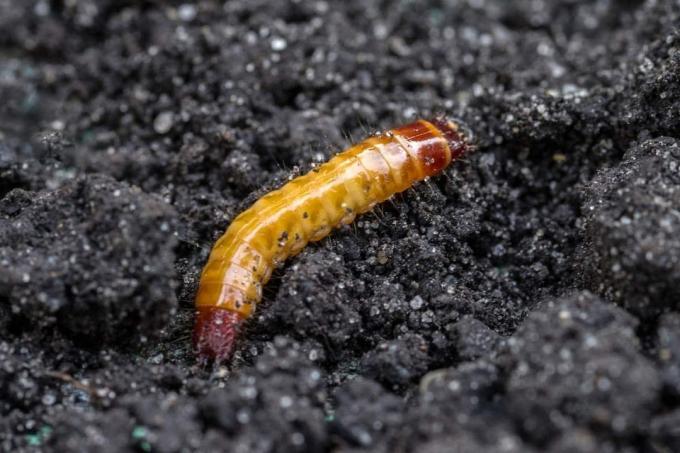
table of contents
- Appearance
- Damage
- causes
- Combat
- Loosen dry soil
- Natural predators ice nets
- Potato trap
- Choose good planting partners
- Preventive measures
- frequently asked Questions
Small worms only several millimeters long are a common damage pattern when rearing lettuce in a raised bed. The most effective methods of treating wireworm infestations are summarized below.
In a nutshell
- Wireworms are the larvae of the click beetle
- spread mainly via the substrate
- mainly eat the roots of plants of almost every species
- can be treated well with natural treatment methods
- preventive measures to prevent infestation are recommended
Appearance
The small worms found in the garden or raised bed are commonly called Wireworms (Elateridae Coleoptera) known.
The living larvae of the click beetle, which have a worm-shaped body, are usually 2 to 2.5 millimeters long. The chitin armor, which is also responsible for the yellowish color, protects the larva and makes them firm and hard in their structure.

In addition, wireworms have the following body features:
- three pairs of legs
- strong bite jaw
- Pointed eyes on the side of the head
Damage
The most common damage caused by a dratworm infestation is plant wilt. By eating away the roots, the water and nutrient uptake of the Salads prevented, which subsequently leads to withered leaves and flowers. An infestation can be recognized underground from the destroyed root areas. Other clearly recognizable symptoms for small worms on lettuce (in raised beds and elsewhere) are:
- rounded feeding tunnels
- weak overall growth
- hardly any resistance when pulling out of the ground
- Putrefaction processes at the feeding points

Note: By eating away the roots in connection with the disturbed self-sufficiency, the Immunization of the lettuce steadily decreases, so that further secondary diseases and pest infestations are more likely will.
causes
The worms and the click beetles are part of the natural biotope of grassland areas. Due to the overall lower moisture and nutrient requirement and the generally higher robustness against pests, an infestation is often difficult to detect on pure green areas.
Through the use of this soil or contaminated substrates acquired in some other way, an infestation can also affect a remote raised bed.
Combat
An existing wireworm infestation can be combated with the help of various methods. In order not to endanger the useful insects in the biotope at the same time, only environmentally friendly variants should be used.
Tip: Depending on the intensity of the infestation, a combination of several measures can be useful to avoid the small worms in the raised bed as quickly as possibleto fight. The effectiveness of the individual action is not diminished.
Loosen dry soil
In particular, drought is poorly tolerated by the pest, which is why it retreats into deeper layers of the earth if there is a persistent lack of water. By loosening these layers of soil deeply, the larvae are brought up and can easily be picked up by hand. A digging fork is particularly suitable as a tool, which due to its shape and the number of prongs ensures uniform penetration of the soil.

Natural predators ice nets
Both the click beetle larvae and these themselves have innumerable natural predators, which represent the most original form of pest control. In addition to a large number of birds, including starlings, crows and chickens, there are also mice, Hedgehog and shrews too. In order to settle these in your own garden, appropriate nesting and Retreat options be prepared. In addition, a large number of insect species can also be used as predators, which can be purchased in a specialist shop if required. These include:
- Ground beetle
- Parasitic wasps
- Predatory bugs
- Lacewing
- Roundworms

Potato trap
Make worms a special delicacy potatoes which are ideal for the production of simple feeding traps. To do this, one skewers about five centimeters thick slices on a wooden stick, sticks it into the earth and covers it with a few centimeters of soil. With a corresponding infestation, countless larvae can be found on the potato after a few days, which are then pulled out of the bed together with the stick.
Choose good planting partners
In the local flora there are various plants that have a poisonous effect on the pest. As soon as the worms start to eat parts of the plant, the toxicity of the plants sets in, which leads to rapid death of the larvae. For this procedure are special Tagetes and Marigolds suitable, which you can simply plant between the lettuce in the raised bed.

Preventive measures
Ideally, an infestation with Elateridae Coleoptera can be prevented at an early stage by taking various preventive measures. Through an intensive preparation of the to be used Soil substrate the larvae can be easily recognized with a trained eye. For this purpose, the earth should be loosened vigorously and searched for any pests. Even after planting, the raised bed soil should be thoroughly loosened and examined on a regular basis. The use of calcium cyanamide has also proven its worth. According to current studies, pest infestation is reduced by up to 30% through use. Calcium cyanamide is also known as a proven fertilizer.
Note: The methods mentioned for combating an infestation are also suitable as preventive measures for the general prevention of a plague.
frequently asked Questions
The female click beetles prefer a moist and at the same time dense soil substrate for laying eggs from April to June. The roughly 200 eggs are laid a few centimeters below the ground to protect them from natural enemies and hatch after about four weeks.
Both legumes and cruciferous vegetables, which include all known types of cabbage, but also turnips, radishes and radishes, are avoided by wireworms. On top of that, beds filled with these plants are not haunted by female beetles for laying eggs because of the oils escaping from the plants.
Since the pest eats its way through the vegetables in corridors, it leaves excrement in them while they are there. In addition, there is an increased risk of secondary infection with fungi and bacteria, which mainly settle at the entry points. Consumption of already infected species should therefore be avoided.
To strengthen the natural immune system of the plants and thus a higher protection against diseases and To keep pests out, the use of agents with higher proportions of phosphorus, potassium and Zinc.
